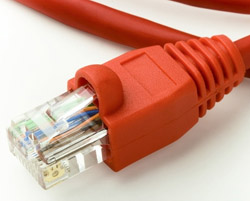It used to be that the only time to worry about a network came with simulcasting and having to plug into the broadcast truck. Now, however, a mixing console may be hooked deeper into a network than even a laptop PC, and the vital links are much more finicky than the good ol’ XLR cables.
Many audio professionals and companies now embrace Ethernet-related technologies. Digital mixing consoles, snakes, and signal processors that make use of Ethernet capabilities are widely available.
Because Ethernet seems to be here to stay, let’s take a look at some of the basic elements of Ethernet data transfer and cabling.
SIZE AND SPEED
Early Ethernet configurations were 10Base-2 or 10Base-5, able to transfer data at a rate of 10 Megabits per second (Mbps) over coaxial (coax) cable. 10Base-2 and 10Base-5 were referred to as Thinnet and Thicknet, respectively, because of their cable sizes.
Because coax was bulky and expensive, networking companies soon developed a twisted pair version of Ethernet called 10Base-T, which also supported speeds up to 10 Mbps. Improved versions of twisted pair cable run at 100 Mbps and 1000 Mbps, and these are called 100Base-T and 1000Base-T (Gigabit Ethernet) respectively.
As a result, 10 Base-T is effectively obsolete in newer systems, and these days, you’ll typically see only 100 Base-T in new equipment. And Gigabit is coming down the line.
Ethernet cable is standardized and consists of four twisted pairs of wires in a jacket that may or may not be shielded. Tight twisting of the pairs improves noise margin and reduces crosstalk of the data, which is transmitted differentially (a data version of balanced audio).
Unshielded versions are called Unshielded Twisted Pair (UTP) and shielded versions are called Shielded Twisted Pair (STP). Each pair within the cable uses a standard color code and has a solid colored wire twisted with a white wire that has stripes of the same color.
Ethernet cables use RJ-45 8-pin telephone-type connectors, and have two standard pin-out configurations: straight-through and crossover.















